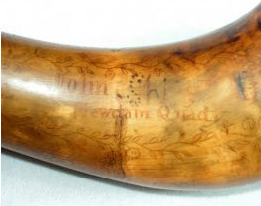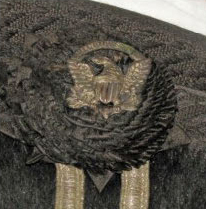Accoutrements
200 - Commodore Charles Morgan Lot
This group of Morgan’s material consists of his Captains epaulettes, a pearl inland mahogany sea writing desk, a dozen letters addressed to him as Commodore dated in the early 1840’s, his inscribed c1840 dress white pants, and a small inscribed tablecloth. The epaulettes supplied by Loudens, a London firm in business from 1835 to 1845, have solid silver eagles.
Charles W. Morgan was born in Virginia in 1790 and was appointed Midshipman on 1 January 1808. He was a senior Midshipman and acting Lieutenant on the USS Constitution and reported on board on 17 June 1810 being transferred from the USS President. He participated in the victories over HMS Guerriere and HMS Java and received a share of their prize money as well as Congressional silver medals. He was promoted to Lieutenant on 3 March 1813. After the War of 1812, he served on the USS Franklin and in June 1824 he was placed in command of the new ship of the line USS North Carolina, as Commander. The Carolina was the flagship for John Rodgers when he commanded the Pacific Squadron from 1825 to 1827. he was promoted to Captain in 1831. Morgan twice served as Commodore of the Mediterranean Squadron, from 1840 to 1844 and from 1850 to 1852 on the flagship USS Independence. They returned to Norfolk in 1852 where he then commanded the Washington Navy Yard. Morgan died in service in Washington D.C. in 1853 at age 63. $6500
198 – Revolutionary War Powder Horn Of Seaman John Leary
This approximately 11 inch powder horn has John Leary’s name in two places: punched in one locale as John Leary and carved John with Newton M. Quady below. Its motifs include a rough ship, florals and a series of geometric designs. John signed on as a seaman on the brigantine Addition, a privateer commanded by Captain Joseph Pratt during the Revolutionary War. At the time of his swearing in on 17 June 1780, Leary was listed as a 26 year old resident of Salem, Massachusetts. $1100
220 – Type III US Boarding Pike
Good example of an early 19th century blacksmith made boarding pike with square pike section. Overall length is 18-1/4 inch with a 7-1/4 inch long square section and 8 inch long langets. The socket has a 1-1/4 inch inner diameter with three 3/16 diameter holes for pike attachment to the shaft. $300 (two available)
C1825 Chapeau De Bras Of Commander John Porter (USN 1806-1831)
This fore and aft hat is constructed of beaver skin and decorated with fine silk ribbons and bullion tassels. The interior has a silk lining and leather sweatband. It is housed in its original 19th century hat box which has been covered with wallpaper. The hat is about 17 inches across and 7 inches high. There is a silver eagle cockade with e pluribus unum banner on a rosette attached by a bullion ribbon with period button (1820 pattern). This piece came from the estate of John Porter and was once in the William Guthman collection. SOLD
Type III Boarding Axe
A good example of a Type III boarding axe with shortened haft. The head is 9 ½ inch wide with integral langets and is pitted from rust. The haft is 13 inches long and tapered. SOLD
Fine Type III Boarding Axe
The finest example of this weapon extant. Everything original with no repairs. Head stamped U.S/N.Y.W/J.T for Navy Yard Washington and Joseph Tarbell, a Navy Captain, the inspector. Perfect intact haft 22 ½ inches long with round ball with two perimeter lines on ball. SOLD
Fine War of 1812 Era British Boarding Pike
A very good example of this British Navy pike. Sharp pike head with 8 inch long langets on a 65 inch haft. Brass plaque with stamped 79 pinned to a well scarred haft indicating significant use. $600






















